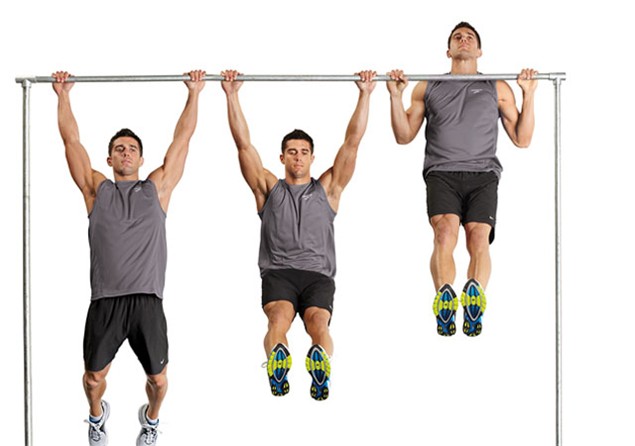
Description
The pull-up is a back exercise that equips your back muscles to exert more through your own body weight. Your grip is of the utmost importance because you are going to pull yourself up with the use of a bar. Your palms must be in a forward position in order to prevent any hand and wrist injury, and to be able to lift yourself.
In order to perform the pull-up exercise, you are required to find a bar, strong and sturdy enough to support your weight. Then, grasp the bar firmly with your whole palms at shoulder width. Your arms must be straightened, allowing your body to hang in the air. That is only your starting position; the real deal is when you pull yourself up until your chin is over the bar or your chest almost reaches the bar, as well. As you are pulling, concentrate on maintaining your body straight at all times without swinging or arching your back. It is important for your back to stay aligned since it is specifically an exercise for the back. Moreover, while doing the pull-up, you can cross your feet, straighten your legs or bend your knees as long as your feet don’t touch the floor, and your back is still straight.
There are common terminologies that are coined with a pull-up—chin-up, which describes having your chin carried on top of the bar, and palms-away, which refers to having a full overhand grip. This exercise helps your body to gain some momentum and balance, and to stay physically fit.
Results
The muscles that the pull-up exercise targets are your latissimus dorsi (the muscles in your back), your brachialis and brachioradialis (the muscles along your elbow that helps move your forearm), your biceps, your triceps, and your shoulder blades. Your abdominal muscles are also targeted in this workout.
The pull-up exercises affect your muscles by flexing and stretching them, most especially your forearms. It also furnishes your shoulder blades to be flexible for better mobility and for being less prone to muscle strain. Your abdominal muscles become more stabilized, resulting your torso to be toned and tough. Your obliques also get tighter as you pull yourself up. When you bend your knees, you also stretch the muscles in your whole legs, making you move better and faster. Your back also becomes straightened, and your spine is aligned, lowering the chances of back pain.
Sets and Repetitions
There are a variety of alternatives to the pull-up exercise. One is the muscle-ups in which you are required to carry your whole torso over the bar while you straighten your arms. Maintain your legs forward while gradually coming down from the bar. This variation is intended for those who already master the rhythm of the pull-up exercise, and who seek difficulty and challenge.
Another alternative is the clapping pull-up, wherein you need to throw yourself upwards in order to have an extra time in clapping your hands and in catching the bar safe and sound. This variation is quite arduous as it involves some precaution. If you are not able to catch the bar as you go up, you may fall down or smack your chin over the bar, leaving you injured.
If you are a beginner, complete 10 repetitions of the pull-up exercise in one set. If you are an advanced trainee, performing 20 repetitions of this workout is sufficient already. Avoid exerting more repetitions that what is suggested because overdoing yourself may bring you muscle strain and even unexpected injury.
Top Performance Metrics
An outstanding performance from a Singaporean athlete, Yeo Kim Yeong, has been able to perform 43 pull-ups in only a minute. Another record has also been achieved by Mark Jordan, who executes 4,321 pull-ups in just 24 hours.
Related Movements
The movements that can be integrated with the pull-up are the following:
Burpees
Mountain climber
Push-up
Squat
Sit-up
Running
Related Foods
Here is a list of foods that you can choose from before you execute your workout:
Fruit smoothie
Whole wheat cereals with strawberries or blueberries
Rice cakes with peanut butter
Banana with almond butter
Your body requires to be refueled after a series of physical demands from the workout. Here is a list of foods that you can add to your menu in order to recharge your body:
Whole grain pita or bread with hummus and veggies
Low-fat chocolate milk
Boiled eggs
Fresh fruit juices or smoothies